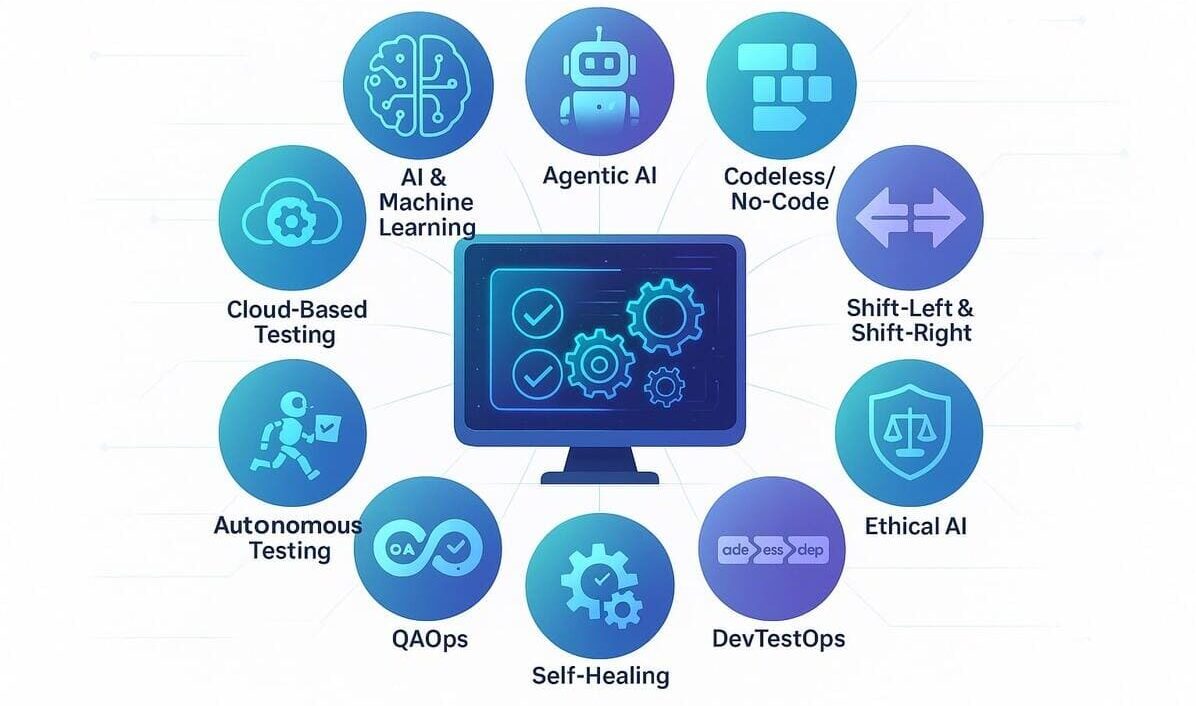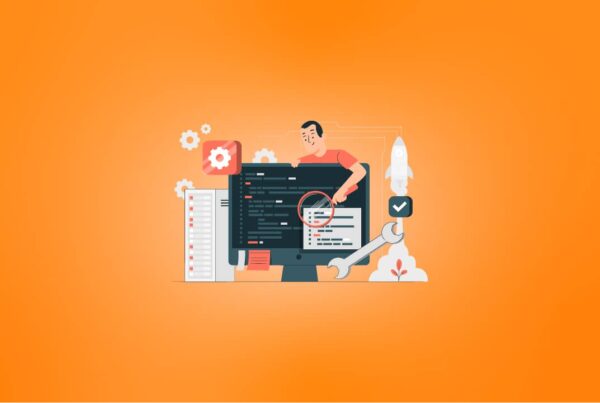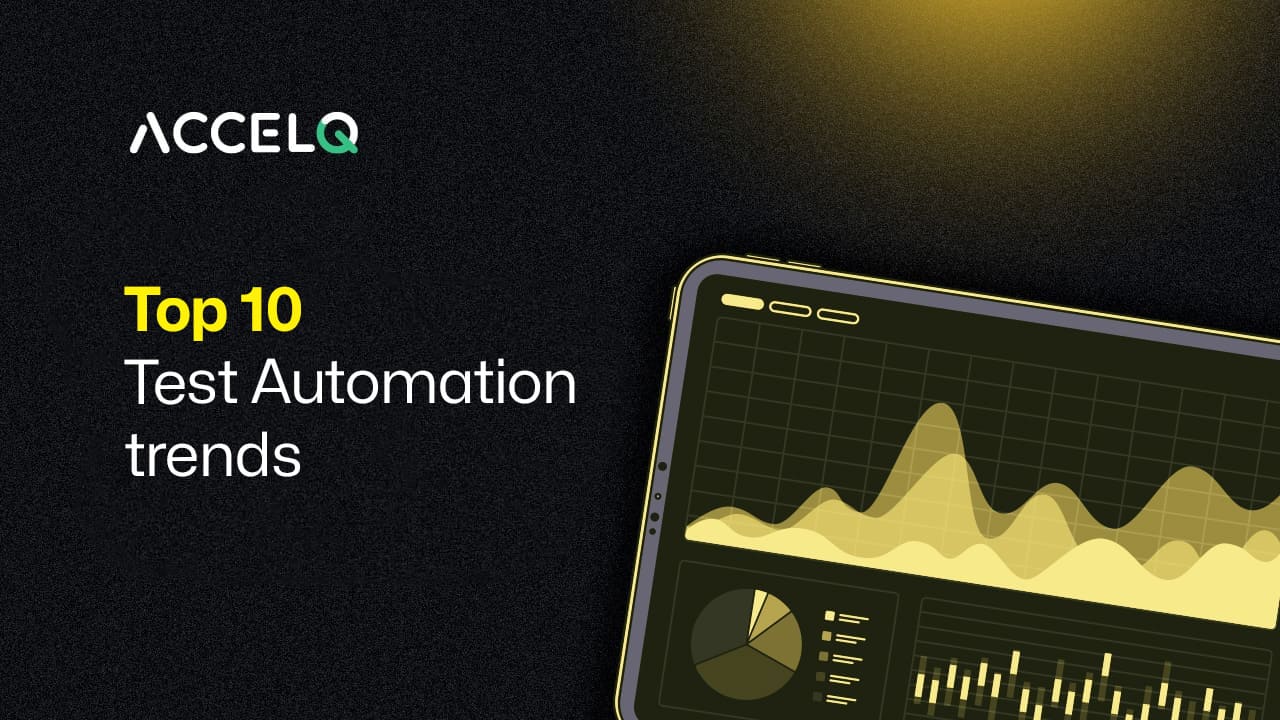10 Best Test Automation Trends to look out for in 2025

Feeling the pressure to test quickly and deliver clean code? You are not alone. Test automation has become the secret weapon for teams that want accuracy, speed, and zero faults in production.
And the numbers back it up—according to MarketsAndMarkets, the automation testing market is set to grow to $55.2 billion by 2028. That’s not just growth—it’s a clear sign that the future of QA is fully automated. The real question is: Are you keeping up?
Let me walk you through the top test automation trends to watch in 2025 so you can stay ahead of bugs, save development hours, and deliver products that users trust by optimizing the entire software testing process. Among the emerging automation testing trends below, AI and No-code platforms stand out. Let’s look into these trends in brief.
Top Test Automation Trends in 2025
Let’s explore the latest trends in automation testing that are reshaping QA in 2025.

1. Artificial Intelligence and Machine Learning
- Artificial intelligence (AI) refers to the use of technologies to build systems that can mimic cognitive functions associated with human intelligence, such as perception, understanding, and responding to spoken or written language, analyzing data, providing recommendations, and more. Machine learning (ML) is an AI subset that automatically enables a system to learn and improve from experience.
- Artificial intelligence and machine learning technologies empower your team to learn and adapt, forming intelligent automation solutions autonomously. AI and ML in test automation analyze data, make decisions, and automate complex tasks.
- ML algorithms can improve various test automation aspects – test case generation, test case execution, and test data management. Hence, these technologies can optimize your business processes and improve system performance.
2. Agentic AI
Agentic AI is a system that operates autonomously, handling tasks that previously required human effort. They communicate and make independent decisions based on interactions to act as a team of highly capable testing assistants. Let’s understand how to apply Agentic AI to automation testing, where an AI agent autonomously manages the full regression testing suite for a big e-commerce platform. Instead of depending on pre-scripted tests and rigid schedules, an Agentic AI system would perform the following actions:
- First analyzes recent code changes and feature releases to prioritize regression tests based on the risk associated with each modification.
- Next, dynamically selects the appropriate tests, choosing a subset of the complete suite based on its risk assessment.
- The Agentic AI system schedules and executes the selected tests across different browsers, operating systems, and devices. If a test fails, it may automatically trigger additional diagnostic tests to gather detailed information about the failure or even attempt to resolve minor issues automatically.
- Further analyzes test results by classifying failures based on severity and might even suggest fixing bugs based on its analysis of common error patterns.
- At last, the Agentic AI system continuously learns from its experiences and refines itself.
🚀 Experience Autonomous Test Automation
With ACCELQ Autopilot, go beyond AI-assisted testing to full autonomy. Generate self-healing tests, optimize execution, and deliver faster — with zero coding.
3. Codeless/No-Code Test Automation
- Codeless test automation is a type of test automation that enables users to create and execute tests without writing code.
- The platform, like ACCELQ, creates automated tests through its intuitive interface, which allows testers to develop tests with drag-and-drop operations and record and playback functionalities. No-code platforms are designed to support advanced interaction and logic development capabilities.
- Hence, non-coding professionals, such as QA professionals, can also easily use this test automation type due to these functionalities.
4. Shift-Left and Shift-Right Testing
- Traditional software testing methods can slow down the development lifecycle by providing input at a later stage. But Shift-Left Testing is an approach that provides faster feedback to help developers rectify defects as soon as possible, thereby reducing the cost and time associated with defect resolution.
- Shift-Right Testing enhances Shift-Left testing, which extends testing into production environments. It uses techniques like A/B testing to gather user feedback.
- Striking a balance between the above testing approaches can help your teams resolve issues early. Combining Shift-Left and Shift-Right testing is crucial in determining software testing methods in 2025.
- These approaches give a well-rounded strategy for achieving continuous quality.
5. Cloud-Based Test Automation
- Cloud testing solutions provide accessible, distributed environments that teams can use on demand to run tests, eliminating the need to perform tests on local machines. The cloud-based test automation approach executes automated tests using cloud infrastructure.
- Software development needs cloud-based test automation because implementing cloud computing systems can deliver quality products at large scales.
- Cloud-based automation testing trends necessitate constant monitoring by QA teams, as they determine the effectiveness and efficiency of their practices in the evolving technological world.
6. Ethical AI Testing
- AI is playing an increasingly major role in test automation, but ethical practices must guide its use. As AI evolves, it can unintentionally produce biased results, resulting in unfair outcomes. And that’s where Ethical AI comes in.
- Ethical AI testing ensures that systems meet key standards, including fairness, accountability, and compliance with the General Data Protection Regulation (GDPR) regulation, which safeguards sensitive data. It involves continuously testing the results produced by AI systems to maintain robustness and safety.
- Thus, prioritizing ethical AI testing, the outcomes become much transparent, fair, and trustworthy.
7. Autonomous Testing
- Autonomous testing is revolutionizing modern software testing by combining AI-based testing and machine learning in test automation. Advanced test automation frameworks can reduce manual effort and boost accuracy.
- Unlike scripted test automation, autonomous software testing enables codeless test automation that adapts in real time. This approach supports continuous testing in DevOps, ensuring quick feedback.
Here are 7 key trends in automation testing to watch in 2025:
- The high adoption of continuous performance testing ensures that applications meet user expectations even under high loads.
- Expansion of automation testing with Selenium and enhanced Selenium test automation frameworks will support wider cross-browser and cross-platform testing.
- The growth of AI testing services will enable more enterprises to adopt intelligent test automation with less human involvement.
- Focusing on a continuous testing framework supports full continuous integration testing pipelines within DevOps environments.
- Interoperability is a standards-based approach to enabling different IT systems to exchange data and share functionality with minimal end-user intervention. This approach will define integration across testing tools.
- AI-driven codeless tools will dominate testing workflows.
The integration of blockchain technology could offer secure, transparent testing logs and improved traceability.
8. Self-healing Test Automation
- New technologies in automation testing, such as self-healing, are gaining momentum.
- Self-healing test automation helps resolve issues that arise when web elements change, including XPath, CSS properties, ID, and Name, which can cause failed test scripts. This technology automatically detects and fixes the issues to overcome test failures and enhance reliability.
The field of self-healing test automation continues to grow quickly, with the following trends:
- Deep neural networks can improve element identification accuracy.
- Incorporating NLP to understand the semantic meaning of UI elements better.
- Using generative models to create new test cases based on application changes.
9. QAOps
- QAOps is a modern approach that mixes quality assurance with software delivery pipelines. It requires the QA team to collaborate directly with the development and operations teams.
- The process begins with the software development and then proceeds to the QA team, which evaluates and finds potential issues to ensure that no quality issues arise before the software reaches the user. QAOps emphasizes the importance of achieving high software quality at every stage of the development process. It is a new flavor of DevOps.
- Continuous integration, continuous testing, and continuous development form the basis of the QAOps approach. It accelerates and smooths out the software development cycle by adhering to the DevOps methodology. You will have more time to work on additional functionalities due to shorter development lifecycles.
In the coming years, you can expect software product organizations using QAOps to streamline their QA process and reap the DevOps benefits in quality assurance.
10. DevTestOps
- DevOps has become a crucial test automation process that enables your organization to deploy changes to a system in production quickly and efficiently. To ensure quality is maintained across all deployments, continuous testing is now being integrated with DevOps, giving rise to DevTestOps. It aims to ensure that changes in the system are deployed in production not only without delays but also without compromising on quality.
- A recent study suggests that a low Mean Time To Repair (MTTR) in production is associated with higher customer satisfaction. A low MTTR means an improvement in the testing process, effectiveness, and tooling. And that is where effective DevTestOps plays a major part.
- Thus, DevTestOps is one of the test automation trends.
Conclusion
The future of software automation testing is towards quantum computing. It has the potential to revolutionize how you approach test automation by enabling computational capabilities that exceed traditional systems. With its ability to process large datasets in parallel, quantum computing opens up new chances for testing complex systems with unprecedented efficiency. The global quantum computing market can reach $8.6 billion by 2027. Hence, integrating quantum computing into test automation brings a massive shift in how we approach complex testing of systems.
While quantum computing is in its early adoption, the trend is expected to grow, driven by the development of advanced tools and methodologies designed for quantum-powered systems. QA engineers with the necessary skills will be at the forefront of this technological revolution.
Key Takeaways
Here are the best test automation trends in 2025 with the most business impact:
- Artificial intelligence.
- Self-healing Test Automation.
- Autonomous Testing.
- Shift-Left Testing.
- Cloud-Based Test Automation.
- Quantum Computing.
You Might Also Like:
 Low-Code Automation Platforms | The Game Changer
Low-Code Automation Platforms | The Game Changer
Low-Code Automation Platforms | The Game Changer
 Take your API Testing to Regression maturity in 3 Steps
Take your API Testing to Regression maturity in 3 Steps
Take your API Testing to Regression maturity in 3 Steps
 Don’t use Manual Test cases for Automation
Don’t use Manual Test cases for Automation
































